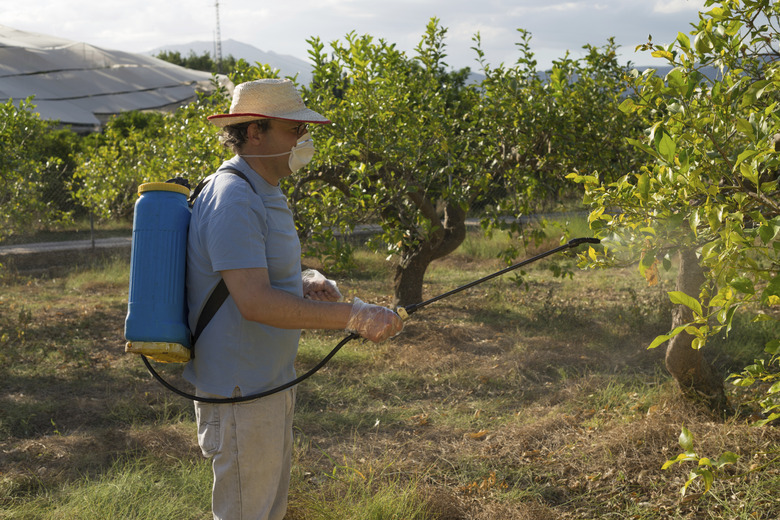How To Mix Copper Soap Fungicide
The battle between fungal or bacterial diseases and garden plants is as old as plant cultivation itself, and often a total mismatch. To boost the odds of winning in your plants' favor, spray them with organic copper soap fungicide as a preventive or at the first sign of infection.
The battle between fungal or bacterial diseases and garden plants is as old as plant cultivation itself, and often a total mismatch. To boost the odds of winning in your plants' favor, spray them with organic copper soap fungicide as a preventive or at the first sign of infection. Knowing the correct way to mix copper soap is essential to success. An excessively strong solution may burn your plants, while an overly diluted one won't help them.
Mixing Measurements
Mixtures of copper soap, also known as copper octanoate or copper salts of fatty acid, vary according to the disease they're treating. One manufacturer recommends mixing between 1 and 4 tablespoons of concentrate per 1 gallon of water to deter a range of fungi on most vegetables, fruits and ornamentals. For some ornamentals, however, the soap-to-water ratio varies with the disease. Treating black spot on ornamental shrubs such as roses (Rosa spp.), hardy in USDA zones 2 through 10, requires 1 7/8 tablespoons, or 1.44 ounces, of concentrate per gallon of water. To treat powdery mildew on the same plants requires 7 teaspoons, or 1.08 ounces of concentrate per gallon. Always follow the label's formula when mixing.
- The battle between fungal or bacterial diseases and garden plants is as old as plant cultivation itself, and often a total mismatch.
- Mixtures of copper soap, also known as copper octanoate or copper salts of fatty acid, vary according to the disease they're treating.
Preliminary Precautions
Copper soap is toxic when inhaled, absorbed through the skin or ingested. The drifting spray may also damage your eyes. Before mixing or spraying it, dress in washable, protective clothing including long pants, a long-sleeved shirt and chemical-resistant, waterproof gloves. Also wear goggles, a respiratory mask, hat, socks and shoes.
Preparing the Mixture
Wait for warm, dry weather to mix your solution. Water releases the soap's fungi- and bacteria-killing copper ions, but too many ions may burn your plants. When cold, wet conditions slow the mixture's evaporation rate, the number of ions and chances of damage increase. Fill a garden sprayer with half the water you need to treat your plant and add the appropriate amount of copper soap concentrate. After agitating the mixture, pour in the rest of the water and agitate again. If you're combining the soap with powdered chemicals, add and agitate the powders first. Continue agitating periodically as you spray, so the solution remains evenly dispersed.
- Copper soap is toxic when inhaled, absorbed through the skin or ingested.
- Fill a garden sprayer with half the water you need to treat your plant and add the appropriate amount of copper soap concentrate.
Recipes for Failure
Mixing chelated or liquid fertilizers containing copper with your soap concentrate could overload your soil with copper. Lime sulfur, Bordeaux mixture and aluminum-based fosetyl-al fungicides aren't compatible with copper soap. If you're uncertain about a specific combination, the University of New Hampshire Extension advises testing it. Pour 2 cups of water into a 1-quart jar and add the appropriate amounts of copper-soap concentrate and the other chemicals, again adding and agitating the powdered chemicals first. After shaking the jar, let it rest for 30 minutes. If the solution remains evenly mixed with no clumping or settling, it's safe for your tank. Make a note of what the mix contains. Before widespread use, spray a small amount on the plants you intend to treat and watch for signs of sun damage or indications that combining the chemicals has made one or both ineffective.
- Mixing chelated or liquid fertilizers containing copper with your soap concentrate could overload your soil with copper.
- Before widespread use, spray a small amount on the plants you intend to treat and watch for signs of sun damage or indications that combining the chemicals has made one or both ineffective.
References
- The Manual of Woody Landscape Plants, Fifth Edition; Michael A. Dirr
- David Austen Roses: Climate Information
- Michigan State University Extension: Copper Formulations for Fruit Crops
- North Carolina State University Extension: Relative Effectiveness of Various Chemicals for Disease Control in Woody Ornamentals in NC
- University of New Hampshire Extension: Compatibility of Mixing Insecticides with Fungicides
